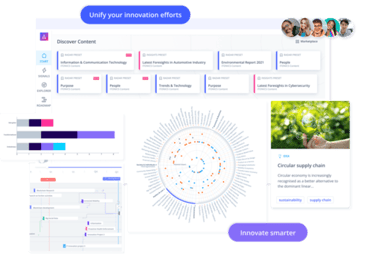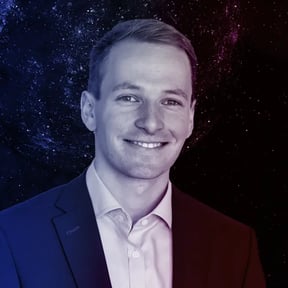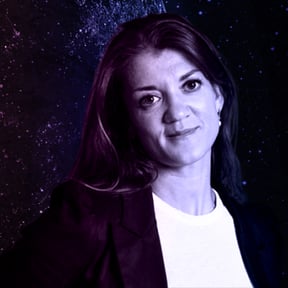“Innovation is not done by one business unit; innovation is done by everyone.”
In this episode, we are pleased to welcome Vera Betz, HR Digital Transformation Manager at o2 Telefónica Germany. Her mission: Connecting people and combining their strengths with the goal of developing the right innovations together.
During this very casual exchange, Vera gives us insights into how HR empowers employees at o2 Telefónica to change and develop new ideas for the future. In this context, we not only learn about the role of trends and how HR operates with them but also what are—according to Vera—the three core competencies that future employees need to bring along for the development of future products.
Below you will find the full transcript for the episode.
HR-driven innovation at o2 Telefónica
Chris: Hi, and welcome back to Innovation Rockstars. My name is Chris Mühlroth, and in this episode, I am excited to welcome Vera Betz from o2 Telefónica Germany in her role as HR Digital Transformation Manager. Vera, thanks a lot for joining us.
Vera: Thank you. Looking forward to this episode.
Chris: Alright, let's go. So we start straight away, as always, with a short 60 seconds introduction sprint all about you, your career, and your current role. So for the next 60 seconds, the virtual stage is all yours. Let's go.
Vera: Thank you. So my name is Vera Betz, and I'm working at o2 Telefónica. I was raised in the bike city Münster, but now living in Munich. I started my career in banking, so I had lots of customer contact as a banking professional. Then I did my bachelor's in communication and started working in a digital transformation program at a bank. I really liked it, so I did a traineeship afterward in innovation and digitalization. And then my master's in entrepreneurship and innovation in English with lots of hands-on projects. I also worked in a sustainability startup during my studies, which I really liked. And yes, now I'm the HR Digital Transformation Officer of o2 Telefónica, and I'm looking forward to building a company for the future.
Chris: That's great. And I guess transformation never ends. So there are lots of things to do. So next up to get to know you a little bit better, I have three sentence starters for you. I would like you to complete those sentences. Number one goes like this: The purchase of 100 Euros or less that has most positively impacted my life in the last six months is...
Vera: Yes, I'm doing a sustainability challenge this year. That means that I only buy clothes second-hand, which leads to not buying clothes at all or buying clothes much cheaper. So one thing I bought for less than 100 Euros was the dress I bought for the wedding of my best friend.
Chris: Very cool. Alright, that's kinda cost efficient. Number two: My favorite song is...
Vera: Actually, I do not have a favorite song. The one band I can always listen to is Seeed. Definitely. And currently, artist Nina Chuba.
Chris: Okay, that's nice. Finally: if I could only work four hours per week in my business, I would focus on...
Vera: I would definitely focus on asking the right question and then listen really carefully to what customers say—focusing on one thing that adds value and then do it.
Chris: Yeah, understood. So can I say this is active listening?
Vera: Yeah, definitely.
Chris: Now, Telefónica: can you maybe, just briefly describe Telefónica Germany, its products, and also its subsidiaries?
Vera: Yes, of course. Telefónica Germany is one of the main communication providers in Germany. We are independent, publicly listed, and our main shareholder is in Madrid. So it's Telefónica’s headquarters in Madrid with a big campus. We provide all kinds of telco services. Also in Spain, Brazil, the UK, and South America. The core brand I think everyone knows is o2. That's the core brand we have in Germany. But some of you might also know Blau or Ay Yildiz.
Chris: Yeah. Is it still “o2: Can Do”—is that still the slogan?
Vera: Yes, it is. We just launched a really big thing there. Maybe some of you listen to the song of RIN and Schmyt?
Chris: You can't get by that. That's true. That's interesting. I learned Telefónica will soon actually celebrate its 100th birthday anniversary. Anything planned, a party, something?
Vera: Yes. So our mother company in Spain will turn 100 in two years. I heard some rumors, but there's nothing specific I can share. But one thing we celebrated this year in Germany was the 20th birthday of our core brand of o2. I think some of the customers saw the o2 Grow Tarife, which was very special for that occasion.
Chris: Yeah, it definitely was. Congratulations on that! Even 20 years is something when you build a nationally- and also then internationally-recognized brand. That's quite cool. Now, I learned that you invest in a framework and a system for innovation management, specifically in Germany, these days. Of course, innovation is already happening today in many different places, right? It's not that we're doing something new. But obviously, it's maybe more about the management part of innovation management. What would you say—why is there a need to harmonize and synchronize innovation efforts? And why start now?
Vera: Yes, I think one of the main things you just said, it's already happening in so many ways. And Telefónica is big, so there are different initiatives we are really proud of. Just to name some of them—that's not a full list here: Wayra, which is the startup accelerator now for ten years with a 5G lab. The technology department with an innovation experience area with several different use cases. And we have a lot of further internal innovation activities within the different business development areas.
"As HR, we want to provide a framework where people can connect, bundle their strengths, and develop the right innovations together."
We feel like there's already so much happening at Telefónica regarding innovation. As HR, we want to provide a framework where people can connect, bundle their strengths, and develop the right innovations together. As I just said, we are a big company, so synchronizing and collaborating is essential to being a future-proof company.
Chris: You already tapped on some of the goals you want to achieve with that—synchronizing, harmonizing. Can you maybe also talk about that? Synchronizing and harmonizing can be the goal itself, but there is a business need and a business outcome behind that. What is your take on that?
Vera: Definitely. We don't do that synchronizing and collaborating for nothing. Our main goal is definitely to generate value for the customers and to grow strategically. We want to have that overview of trends and the relevance to really prioritize our innovation activities.
Chris: And also what we see specifically in large organizations, and also global and/or international organizations, is that there is so much happening; sometimes you even don't know what exactly is happening, and there might be some overlaps, right? There might be some learnings made by somebody in a department somewhere around the globe. This knowledge or these capabilities might be interesting and necessary for another project currently running in a different department, but nobody knows. So it would be great to connect those people together and say, “What you're working on is great. We have the same thing. So do we want to collaborate? Do we want to do that instead of having two separate things?” That's something that, for example, happens in large organizations for sure. And bringing transparency to that really helps a lot. To also be able to focus the resources—not only financial resources but also the Human Resources. By the way, Human Resources is a great tagline because I'd be utterly interested in why you're driving [innovation] by HR. But before we do that, I actually would like to play a quick game. The game is called “Either-Or.” Really simple; this is how it works: I give you two options. You choose one of those options and then spend one or two sentences each to explain why you chose a specific option. Speed is key in that game. Right, let's start. Number one: Mac or Windows?
Vera: Windows but iPhone. So I think there’s nothing more to add.
Chris: Interesting combination.
Vera: I started using Windows, and then all the companies I worked for, everyone used Windows, so I did that too. But privately, I prefer iPhone. And yes, as mobile-first is happening, I’ll stick to that one device.
Chris: Okay, number two: going to the cinema or Netflix?
Vera: Netflix, especially home makeovers.
Chris: It's an ongoing debate, I know, but okay, got your choice. And finally, when discussing matters with your co-workers, when building this innovation management initiative, do you either go for emails these days—because it's all virtual—or actually for real, in-person conversations?
Vera: In-person conversations because you get so many more details, and you get the mood and everything. I feel like long emails are not the right way to go with innovation.
The important interplay of people and process
Chris: Now let's go back to Telefónica, and let's talk about why you're driving this within and by HR. That’s really interesting; why did you decide to go this way?
Vera: Yeah, as I just said, we, as Telefónica, are pretty big and really successful at the moment. But we need to develop those new businesses to stay relevant for the future. There is no other option. And we decided to do that as HR because innovation is also part of a company culture. We aim to influence that company culture as HR. We want to shape our organization to be future-proof. I can say that we see HR as the driver for corporate development that enables employees to transform and develop new ideas for our future. So we want to be the connector, you can say, within our company.
Chris: So would you say that capability comes before process? Like, care about people and their capabilities prior to installing rigid innovation management processes?
Vera: I think both are important. People can't work without processes, but if you only have processes and no one is really involved, that won't work as well. So I think both are important, but you really need to focus on people because no process will ever work if you don't care about people.
Chris: What I understood from you is that early in the process of actually setting up innovation management, you and your colleagues had the foresight and realized that innovation starts much, much earlier than just collecting ideas, working on ideas, and developing them into a great potential innovation, then bringing new products to market. It starts much, much earlier. On a very high level, how do you design the innovation management process? Where does it start? How far do you go? And what are some of the components of it?
"Innovation is not done by one business unit; innovation is done by everyone."
Vera: You've just said not to do it on a high level, not to go into too much detail. So as you just said, we want to focus, of course, in the beginning on scouting some trends. There are so many trends around us that all the innovation managers within Telefónica are already looking at. If we synchronize those trends and managers can talk to each other, that's a first, really important step we want to take. Because as we just said, innovation is not done by one business unit; innovation is done by everyone. Everyone needs to be involved, especially in those first steps as well. It doesn't work if no one understands why some of those trends are chosen to be the important ones. We want to look at those trends from different angles, and then we can decide together where we want to dig deeper. The environment is for everyone the same, so if we have the different capabilities to discuss and prioritize [trends] together, we can really find those things that fit into our strategy.
Chris: So the ambition, if I understood this correctly, is to raise all the boats at the same time, right? Because you provide transparency into trends, for example, of customer demands. Where are customer demands heading? What is with emerging technologies? What is with existing technologies or trending technologies? How would they fit? What customer needs could be addressed by applying a certain technology? Can technology already be applied today or not? What is the technology readiness level? There are many questions. And I assume that if you have distributed innovation activities, at some point, everybody cares about those questions anyway. Having a shared understanding of that probably helps in saving time, but also making sure [efforts] actually run in similar directions. That's a high-leverage activity, which is pretty compelling for the entire organization.
Making trends snackable
Chris: Can you give us maybe one example of a trend you have on the radar and how you work with trends in general?
Vera: Definitely, I can give you two to show the difference of various trends we have on our radar. The first one is [within] HR. It's very obvious because it's [been] happening for quite some time. It's flexible workplace. We started with ours in 2020, and it's ongoing. And that trend evolves; more and more trends arise. One challenge we currently look at is the sense of belonging. If lots of your employees work from home normally, how do you shape your company spirit and stuff like that? That's one thing belonging to that trend that's currently an issue, I think, for lots of companies. To give you another trend that's not as obvious and is further away. We want to look at some tech trends as well—where we don't know yet if they could be important in the future or not. For example, if you have a trend, like brain-computer interfaces, currently, that's not a topic we need to dig deeper into, but maybe for the future. We need to have those on our radar as well. Where we think, “Okay, maybe in the future, that's something we need to look more specifically into.” Then the other question you asked was how we work with those trends. I'll give you a small example from our team meetings. We have a forum that's called “Trends Snack.” We use 10 minutes in each team meeting to discuss some future trends in three different parts. The first part of the definition, so everyone in our team has the same understanding of what the trend is. The next part is a use case or an example so you understand more about the trend and see how it is applied in the real world. And the third part is, what impact could that trend have on us as Telefónica or on our HR organization? That's something really quick that you can implement in your daily or weekly work. It helps to discuss, get new perspectives, or get inspiration for maybe even current projects we are working on.
Chris: I think that's a nice format—a snackable format—right? To ingest this into different teams or different team meetings. That's a great idea. Not only for you but for many organizations we work with, [it’s important to] answer the questions: Why change? Why now? Why should we care? Why is this important? What's probably the impact on the business? These are some tough questions. Because, of course, transformation and change is always something that requires an effort. You need to be bold and brave to go through that. Because otherwise, it's information, but why should we care about this? If you have some good arguments, then they listen, right? If you can say this will impact our product portfolio or something we're already working on, which may become more important or now obsolete, because things change. So those are important signals or impulses you can give to different teams.
Vera: Definitely. Just one example: once we discussed more deeply about diversity topics. And then one colleague said, “We have a diversity topic here. Maybe we can include some parts of our discussions so we get even better in our current projects.” So it can be something really tangible for the moment as well.
Core capabilities and tips for successful innovation management
Chris: From your HR perspective, what are some of the skills that future employees need when developing future products? Innovation, that's a broad term, but what are some skills and capabilities that you think are required to have going forward?
Vera: I think the first and most important thing is curiosity. Employees need to be curious and try to experiment. Don't be fearful, I'd say. Then another thing is focus on the relevant tasks because there's so much happening everywhere in every company for every position. So have the big picture in mind, I'd say. Then focus, of course, on customer needs, what really adds value, and then prioritize and start doing. And as we just said in the beginning, the collaboration part, that's crucial for everyone. You need to collaborate not only within your company but also externally. You need to be communicative, talk to others, and while developing, especially talk to customers as early as possible, I'd say.
Chris: Yeah, definitely. Because otherwise, tapping into the “solution-seeks-problem trap” is very costly. So I totally agree. So when we try to summarize what we discussed during this episode today, what are your three key actionable recommendations that you would want listeners to take away from this episode with you?
"HR really can support innovation with a focus on organizational development and culture."
Vera: I think the first part is the one I just ended with: collaboration. Collaboration within big companies is crucial for innovation. We really need to do that. The second part is referring to HR. HR really can support innovation with a focus on organizational development and culture. I think that's another takeaway that can be really important for other companies. Lastly, the customer-first part. Always testing iterations. Always use your internal customers as well. That’s a thing we often do within HR; that if we want to implement a new ticket or something, we test it with our customers so everyone understands what it's about—have the most important stuff in there.
Chris: Got it, alright. And when you look at your professional career, Vera, I need to know, what were your greatest Innovation Rockstar moments so far?
Vera: Again, as I said, in the beginning, with the songs, for example, there's not one big moment. But I really enjoy moments where I present solutions. Those moments are really great. And also little moments should be appreciated as well. For example, last week, someone told me that due to my working style, she implemented the customer view in her daily routine as well. That was such a compliment—connected to innovation. It was just a little moment, but I think those moments are Innovation Rockstar moments as well.
Chris: Okay, so you collect a myriad of Innovation Rockstar moments along the way. That sounds great. And with that, we already wrap up this episode. Thanks for joining. Really interesting what you have built and obviously continue to build. Sounds like you're after something great!
Vera: Thank you so much, Chris, for having me here. I'm looking forward to listening to all of your episodes and to all the other ones who will follow.
Chris: Thanks, and to everybody listening or watching, if you liked the show, then leave us a rating or review and share the podcast if you think it's interesting to somebody. If you want to get in touch, simply shoot us a message at info at info@innovationrockstars.show. Now that's it. Thanks for your time again. See you in the next episode. Take care and bye-bye.
About the authors
Dr. Christian Mühlroth is the host of the Innovation Rockstars podcast and CEO of ITONICS. Vera Betz is HR Digital Transformation Manager at o2 Telefónica Germany.
The Innovation Rockstars podcast is a production of ITONICS, provider of the world’s leading Innovation Operating System. Do you also have an inspiring story to tell about innovation, foresight, strategy, or growth? Then shoot us a note!

See the ITONICS Innovation OS in action





